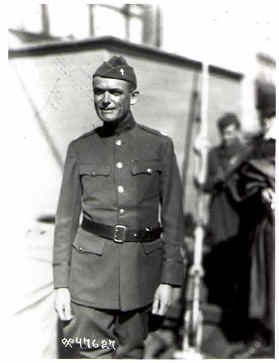

Article taken from www.sixtyninth.net
Father Duffy Article
FRANCIS P. DUFFY (1862-1932)
The most celebrated U.S. Army chaplain in the Great War, Father Francis Patrick Duffy, a Roman Catholic priest, was born in Cobourg, Canada, and was ordained in 1896. He attended the Catholic University of America in Washington, D.C., and then was appointed professor of psychology and ethics at St. Joseph’s Seminary in New York. Father Duffy’s career as an Army chaplain began with a brief tour of duty during the Spanish-American War when he was stationed at Montauk Point, Long Island. In 1912 he became pastor of Our Savior parish in the Bronx, and in 1914 he was appointed chaplain of the 69th Infantry Regiment of the New York National Guard.
The "Fighting Sixty-Ninth," a basically Irish regiment, although containing members of other ethnic groups, had served with distinction during the Civil War. It was called up briefly during the Spanish-American War, and also in 1916, when it served on the Mexican border during General Pershing’s Punitive expedition. When the United States entered World War I, the regiment was renumbered the 165th Infantry and assembled at Camp Mills, New York. Assigned to be part of the new Rainbow (42nd) Division, its members continued to refer to the regiment by its traditional sobriquet.
Chaplain Duffy, by now a major and the senior chaplain of the 42nd Division, became an inspirational focus for the division and later for the A.E.F. The poet Joyce Kilmer writing about the voyage of the division across the Atlantic, observed that every day there could be seen a line of soldiers, "as long as the mess-line," waiting their turn to have Duffy hear their confessions. Every morning, Kilmer noted, a large crowd of soldiers would gather amidships on the transport where Chaplain Duffy would say Mass at an altar made from a long board resting on two nail kegs. Arriving in France in November 1917, the division spent the winter training and in late February 1918, took over front-line trenches from French forces at Luneville in the Lorraine sector. At dawn on March 20, Duffy and the men of the 42nd received their first serious baptism of fire when a barrage of mustard gas shells burst among them. The bombardment lasted two days and there were over 400 casualties, the majority of them blinded.
For Chaplain Duffy, the next few months were to be filled with such scenes. He was most often found along the front lines hearing confessions and saying Mass, as well as visiting and counseling the soldiers. It was by his ‘ministry of presence’ that he had his greatest influence and became an almost a legendary figure. Once the fighting began, he often traveled with a unit first-aid station, providing physical and spiritual care to the wounded and the dying. His presence on the battlefield was inspirational. Duffy was always near the heaviest fighting, exposing himself to constant danger as he moved from unit to unit. His decorations included the Distinguished Service Cross and the Distinguished Service Medal.
After the war, Duffy returned to a new parish in New York City. As pastor of the Holy Cross Church on 42nd Street, just off Broadway, the "actor’s Church,’ Father Duffy added to his already great popularity. In 1919, he published a best selling book, Father Duffy’s Story, chronicling his experience in the Great War. He died on 26 June 1932.
Pastors Holy Cross Español Holy Cross English Index Español English Index